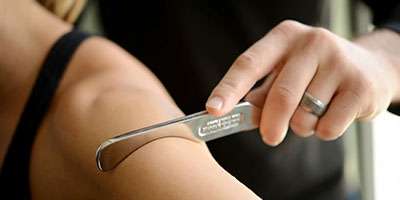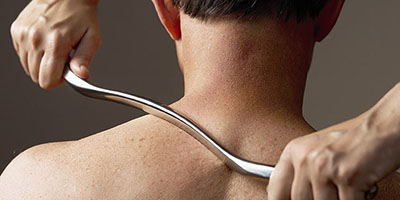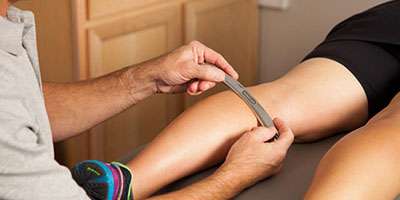Graston Technique®
Manual Therapy Using Specialized Stainless Steel Tools To Treat Areas of Restriction

Graston Technique® is an innovative form of instrument-assisted soft tissue mobilization that locates and efficiently breaks down fascial restrictions and scar tissue. It also helps to improve flexibility and maintain optimal range of motion. It is known to be a successful, non-invasive option for treating soft tissue injuries and conditions, both chronic and post-surgery.

This evidence-based therapy uses specialized stainless steel instruments to assist our Graston certified practitioners in identifying and treating areas with soft tissue fibrosis or chronic inflammation. The instruments are moved over the affected area, contacting the various adhesions and restrictions, and work to break-up the scar tissue and fascial restrictions caused by injuries.

After consistent treatments, Graston can minimize or eliminate any adhered fibers, restore optimal range of motion, and remove associated pain and discomfort. Your soft tissue injuries will be transformed into healthy functioning tissues. Your Graston practitioner will recommend an appropriate treatment frequency based on the health conditions or injuries that you wish to be addressed.
The Graston Process
Graston Technique® (GT) is a form of instrument-assisted soft tissue mobilization. Your practitioner is trained to identify specific areas of fascial restriction, or injured fibrotic tissue, and utilize a cross-friction technique, with specially designed stainless steel tools, to break down scar tissue.
The fluid movement of muscles, tendons, fascial, and ligaments, can be greatly affected by scar tissue and various adhesions. The Graston instruments we use are designed to glide over any adhered or restricted tissues, allowing us to identify them and then provide the required treatment. The tools, themselves, are used to effectively break down any scar tissue, reducing or eliminating any adhered fibers, restoring optimal function in the tissue, and decreasing any associated pain.
Graston Instruments & Tools
- There are 6 tools used in Graston Technique® treatments.
- The tools are finely-crafted out of stainless steel.
- The various tools offer different bevels (concave & convex) and shapes that can conform to the adhered tissues better than our hands.
- The tools have rounded edges and are not sharp.
- To better locate and diagnose scar tissue and fascial restrictions, Graston tools are designed to transmit specific sensations back to your practitioner.
Goals of Graston Technique®
The general goals of the Graston Technique® are to reduce pain and increase function through a combination of the following:
- Breaking down the scar tissue and fascia restrictions that are usually associated with some form of trauma to the soft tissue (e.g., a strained muscle or a pulled ligament, tendon, or fascia).
- Reducing restrictions by stretching connective tissue in an attempt to rearrange the structure of the soft tissue being treated (e.g., muscle, fascia, tendons, ligaments).
- Promoting a better healing environment for the injured soft tissue.
BENEFITS of Graston Technique®
- Increase the flow of blood, bringing the good stuff (i.e. oxygen, platelet derived growth factor) to the injured or dysfunctional area.
- Reduce areas of sensitivity – those areas that are very sensitive or tender.
- Break down areas of restriction, “stickiness,” in the soft tissues of the body. Want to know more about how this happens?
WHO CAN Benefit FROM Graston Technique®?
If you have sustained an injury to a muscle, ligament or tendon then you will develop scar tissue during the healing process. While scar tissue is a necessary part of your recovery it can sometimes lead to restrictions and dysfunction in the tissue or joint that it is acting on.
People who have sprained a ligament or “pulled” a muscle such as in the ankle, knee, shoulder or arm, should access this treatment early to prevent the excessive formation of scar tissue and ensure that their joint or muscle can function properly and thereby reduce the chances of an unnecessary chronic condition occurring.
Those who are already dealing with a chronic issue related to scar tissue can also benefit from the technique as it allows us to manage chronic adhesions as well.
CONDITIONS TREATED BY GRASTON TECHNIQUE®
- Ankle, knee, wrist, elbow sprains and strains
- Acute and chronic sports injuries
- Achilles Tendinosis/itis
- Carpal Tunnel Syndrome
- Cervical Sprain/Strain (Neck Pain)
- Groin pain
- Hamstring pain/tightness
- Headaches and Migraines
- Jaw “TMJ” pain
- Lateral Epicondylosis/itis (Tennis Elbow)
- Lower back pain from strains, degenerative changes, disc pathology or joint dysfunctions
- Lumbar Sprain/Strain (Back Pain)
- Medial Epicondylosis/itis (Golfer’s Elbow)
- Neck pain from strains, degenerative changes, or joint dysfunction)
- Patellofemoral Disorders (Knee Pain)
- Plantar Fasciitis (Foot & Heel Pain)
- Quadricep pain/tightness
- Rotator Cuff Tendinosis/itis (Shoulder Pain)
- Scar Tissue
- Shin Splints
- Thoracic pain (Upper back such as between the shoulder blades)
- Trigger Finger
- Whiplash injuries
- Women’s Health (Post-Mastectomy and Caesarean Scarring)
During The Treatment
- The practitioner will utilize the appropriate Graston Technique® instruments to scan and then treat the affected area(s).
- Treatment generally consists of the clinician rubbing the affected area(s) with the handheld stainless steel Graston Technique® instruments, using very specific, calculated massage techniques.
- Using a cross-friction massage, which involves brushing or rubbing against the grain of the scar tissue, the practitioner re-introduces small amounts of trauma to the affected area.
- In some cases, this process temporarily causes inflammation in the area, which in turn increases the rate and amount of blood flow in and around the area.
- The theory is that this process helps initiate and promote the healing process of the affected soft tissues.
- Treatment time is usually 30 to 60 seconds per area treated.
- It is common for patients to experience some discomfort during the procedure.
After The Treatment
- Patients are advised they may be sore, bruised or exhibit small red dots over the area treated, called petechiae.
- If any soreness is felt after the procedure, ice application for 15 to 20 minutes following the treatment may ease the discomfort.
- It is recommended that an exercise, stretching, and strengthening program be used in conjunction with the Graston Technique® to rehabilitate the back and help the injured tissues heal.
- Anecdotally, many patients have reported increased range of motion and reduced pain after the first treatment.
FAQs About Graston Therapy
Absolutely! At Refined Health & Wellness, our Graston practitioners have received specialized accreditation and training. Since Graston Technique is performed by registered massage therapists who are certified in Graston Technique, treatments are eligible for reimbursement by 3rd party insurance with massage therapy benefits. Direct billing for Graston Therapy is also available.
Scar tissue can be formed during the normal healing process whenever your body’s tissue is damaged. Scar tissue is not only external, ie. from cuts or scraps, but also forms internally when we injure our ligaments, tendons, or muscles. Ultimately, scar tissue is not as functional as the tissue that it replaces.
When scar tissue forms after injury, our body produces collagen excessively. The initial production of granulation is necessary to provide tensile strength to the injury site. In certain circumstances, the granulation leads to contraction of the scar and to poor structural organization of the components of regenerating muscle and scar tissue. This leads to a lack of flexibility in the tissue and often this poor structural organization can cause pain and dysfunction.
We like to use a paint brush as an example. If we take the correct steps to store the brush after use, we can pull out the brush and use it easily for our next project. The brush starts out as a soft, supple parallel group of bristles that can bend easily in many directions. If we simply let the bristles dry, they start to bind to one another and the brush loses its flexibility and function. The brush cracks and bends irregularly. At this point more care is required to rehabilitate the brush and get it back to work. Hence early diagnosis and treatment of the brush is a necessity.
It is important to know that all injured tissue will develop scarring to some extent. When the scarring prevents normal function of the affected tissue or joint, pain or restricted function exists. This is why we encourage all of our clients to have their injuries assessed, to receive advice in the early stages of injury and to have a proper treatment regime started.
Graston Therapy in St. Albert
Graston Technique® is available at our St. Albert massage clinic through select Registered Massage Therapists who have acquired specialized training and accreditation.
Graston treatments can be received by anyone, from elite athletes to everyday clients.
Questions about Graston Therapy? Please reach out to us at [email protected]
